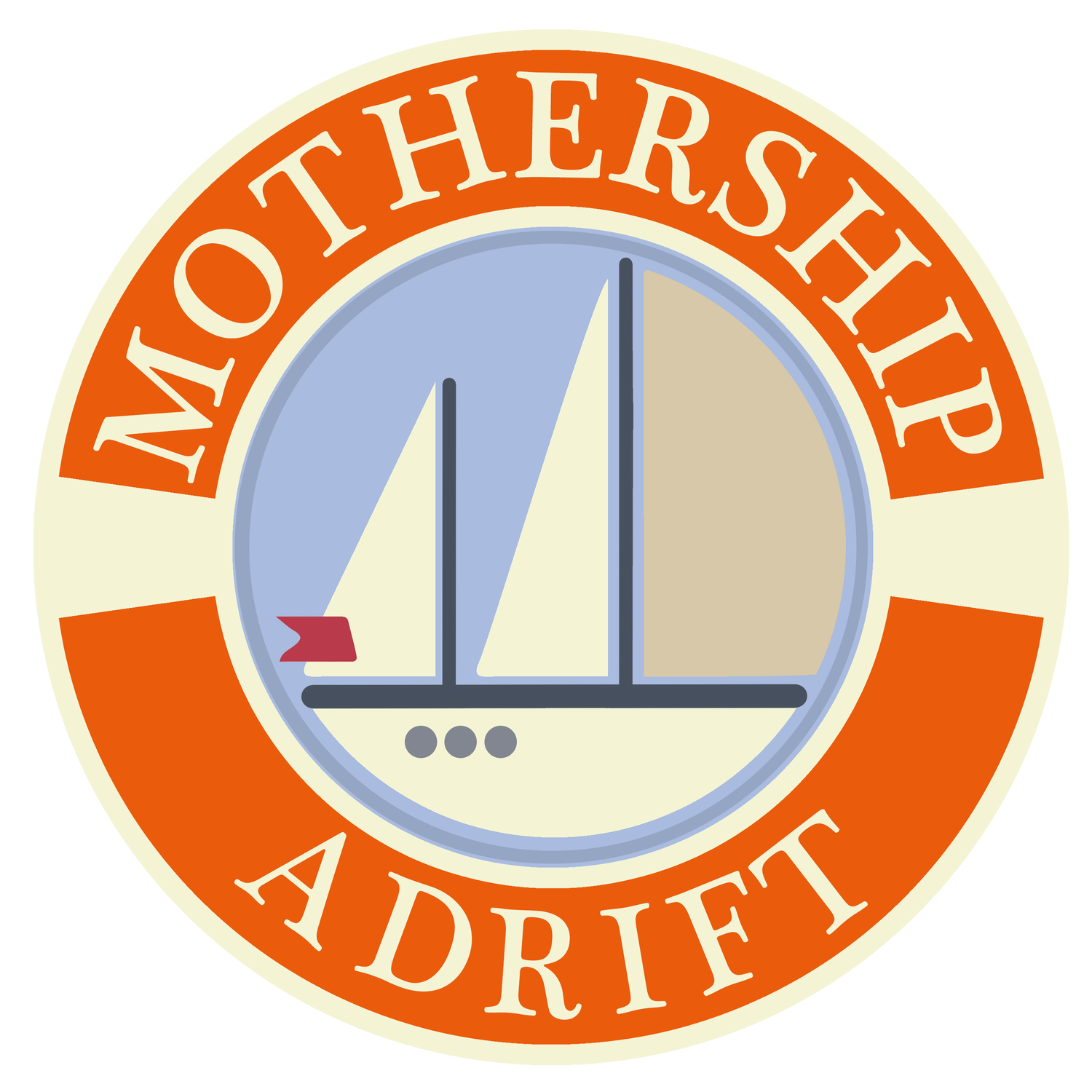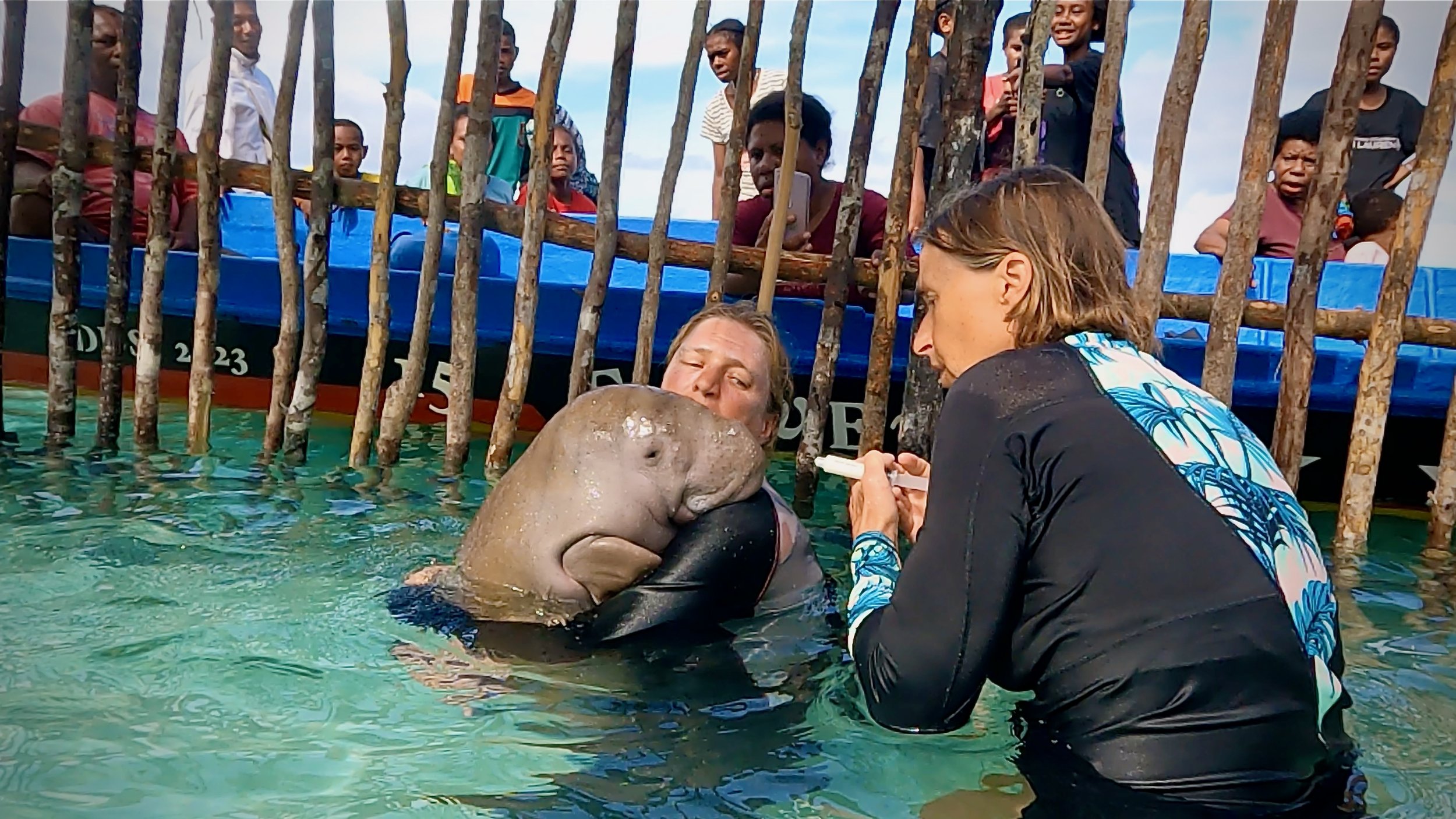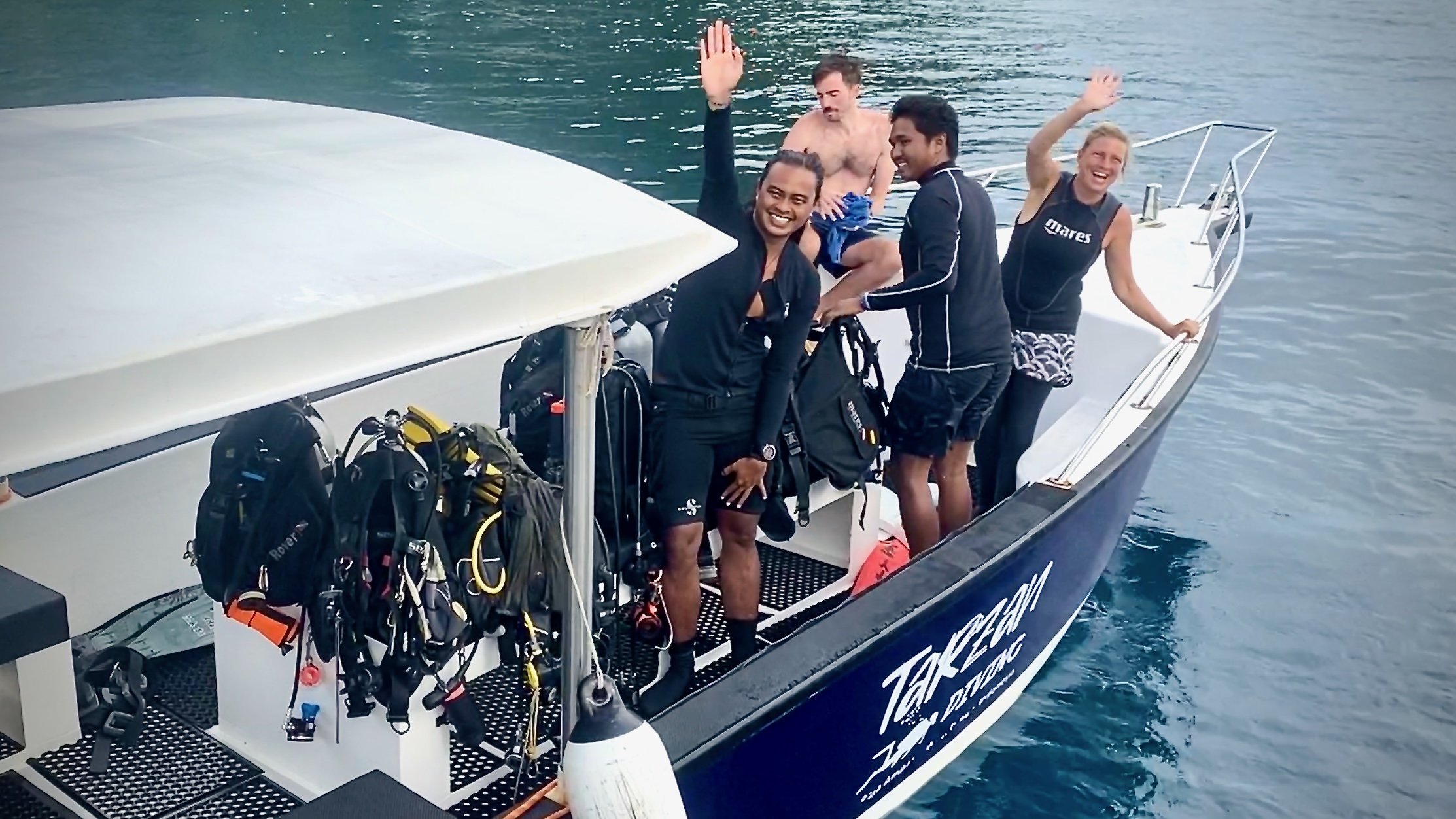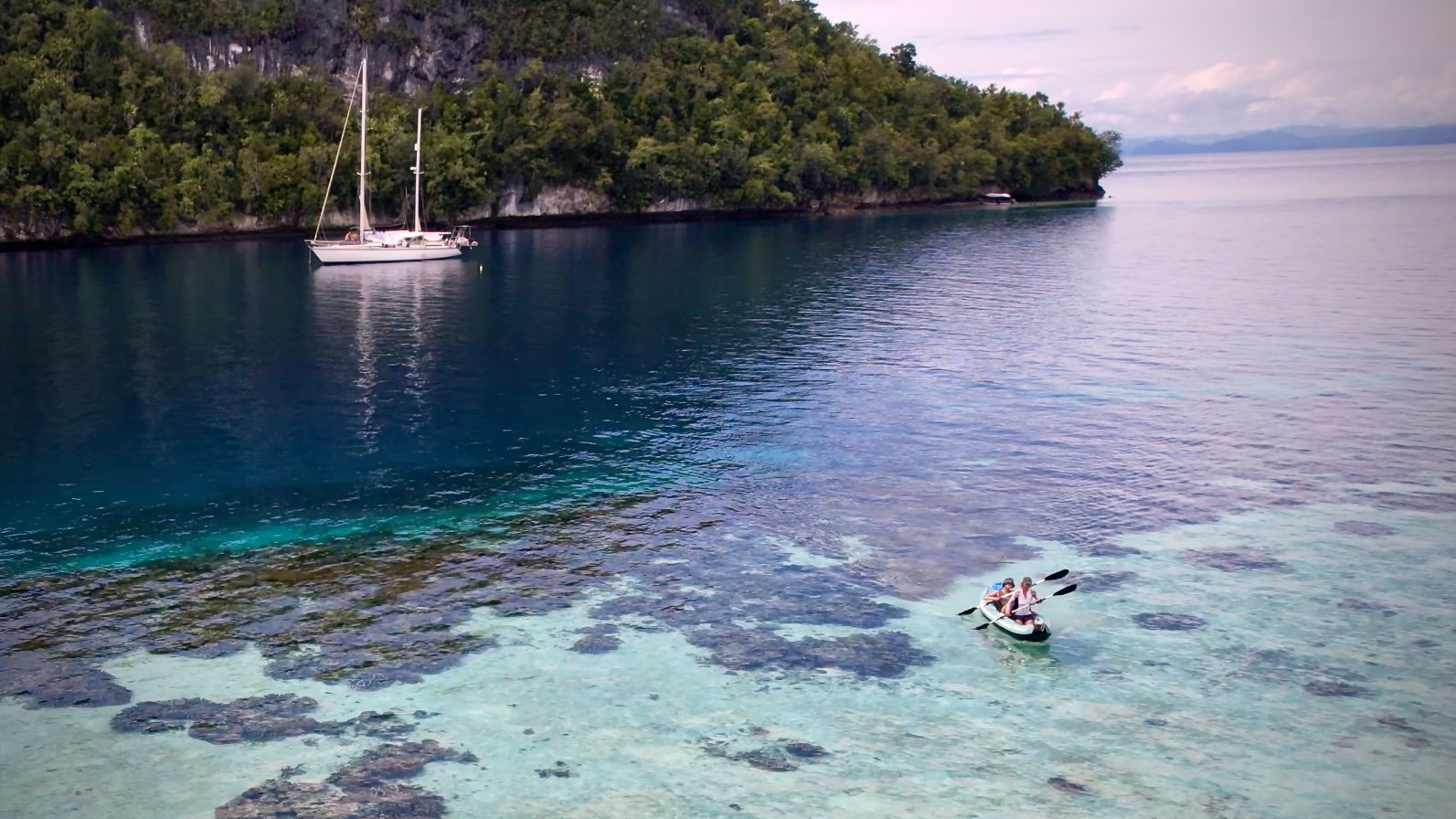Appeal for Assistance: Endangered Dugong Calf in Distress
Irenka and Heike attempting to feed the dugong calf in the wooden trap
01:02:03i
The full story behind our urgent appeal
Many years ago, I used to read a book to my kids called *Mary Manatee*. It was the tale of a baby manatee that became separated from its mother. Spoiler alert – Mary eventually found her way back to her mother, and the story had a happy ending.
That fascination with manatees and dugongs never left us. Years later, and now sailing through Indonesia with the kids, we had a chance to see these gentle, majestic creatures up close.
We are currently anchored in the Raja Ampat region during the Indo-Pacific leg of our eight-year circumnavigation. The biodiversity in this part of the world is second to none, recognised as a UNESCO World Heritage site and a Coral Triangle Marine Protected Area. In our short stay near Wajag, we trekked to see birds of paradise, watched manta rays feed from the bows of our boat, and dived the coral reef to see black-tipped reef sharks, wobbegong sharks, clownfish, and even a rare seahorse or two.
The Raja Ampat region is a recognised UNESCO World Heritage site and a Coral Triangle Marine Protected Area.
So when a guide from the local village offered to show us dugongs in the wild, we jumped at the chance to see this secretive and endangered species.
At 6 am the following morning, we sat alongside his large canoe in our inflatable kayak, watching the sun come up over his nearby island. Ripples began to appear on the still surface, and then the curved backs of dugongs broke the water as they gently slid through it. Eventually, an entire herd passed us by. I had always presumed dugongs were fairly cumbersome and docile, but they moved surprisingly stealthily through the water, following their regular route between grazing areas.
Once they had passed into open water, we all began to breathe again. It was a magical moment and one we would never forget. Then our guide surprised us. He asked if we would like to see a baby dugong. Assuming he was going to take us to another grazing area, we enthusiastically agreed and loaded our inflatable kayak precariously onto his canoe, motoring towards another bay.
It was only when the guy pulled apart a small section of the trap and beckoned us in that we realised the dugong calf was actually inside.
About 15 minutes later, we approached some holiday cottages elevated on stilts above the beach. In the bay was what looked like a large fish trap, being attended to by a man on another canoe. As we approached, he indicated for us to put on our masks and get in the water. It was only when he pulled apart a small section of the trap and beckoned us in that we realised the dugong calf was actually inside it. We discovered later that two teenage boys from the local village had separated it from its mother and now charged tourists to see it.
The trap in which the dugong was held.
We were all visibly uncomfortable with the situation, but our guide seemed delighted that he had given us this opportunity and ushered us in. After a quick discussion, my wife and daughter agreed to check on the calf and get some footage, while my youngest son and I took footage from the outside. My 15-year-old son, a budding naturalist, was angry and refused to take part.
It was the most forlorn sight we had ever seen, and our mood on the trip back was somber, to say the least. It is not often our family collectively agrees on anything, but back on the boat, we decided we had to do something.
The Dugong Calf inside the wooden trap
We knew dugongs were an endangered species, slow breeders, and infant mortality was tragically common. There was no phone coverage in the area, but luckily we had installed Starlink on the boat in Fiji. Some quick research informed us that capturing dugongs in Raja Ampat was not only illegal but could result in severe penalties and even imprisonment.
Capturing dugongs in Raja Ampat is illegal and could result in severe penalties and imprisonment.. and yet…
We did not want to interfere with the local community or get the boys in trouble; after all, they were just budding entrepreneurs trying to make money from tourists. But we gleaned from our guide's broken English that the calf had already been separated from its mother for anywhere between 2 and 4 weeks, and they had been trying to feed it rice.
The dugong calf has been separated from its mother for anywhere between 2 and 4 weeks
What’s more, we were off-grid, miles away from any authorities, and anchored right next to the village where the boys were from. We didn’t want to antagonise what were essentially our hosts and knew the situation required delicate diplomacy. But time really wasn’t on the calf’s side.
The only local we knew who spoke English and Indonesian was a German dive instructor, Heike, we had met the previous day who lived on a nearby island with her Indonesian husband.
Heike, a German dive instructor from Tarzan diving was the only person we knew who could speak both English and Indonesian.
So we contacted her, and to our immense relief, she jumped into action. On seeing the calf for herself, she arranged for marine vets from Sorong, a day away, to come to the area. Not only that, she organised for us all to meet with the local village chief that very afternoon.
The village chief was a woman, so it was decided that only Irenka and my daughter Rowan would go to the meeting to represent the calf as a mother and daughter rather than interfering white western tourists with an overbearing environmental agenda.
Rowan and Irenka kayaking to the local village from the boat
In another twist, one of the boys who had trapped the calf was also invited to the meeting, and after a long, largely amicable discussion, it was agreed that the boy would release the calf himself the following day. It would have to be timed precisely at high tide when it was hoped the herd would be at the seagrass feeding area nearby, and the calf could rejoin its mother.
The relief was immense. It seemed we had trodden a delicate diplomatic path in arranging for the calf to be professionally assessed and negotiating its release, all without upsetting the local community or getting the boys into serious trouble with the authorities.
But it was too good to be true.
Heike greeting the vets from Sarong
The following morning we met with Heike at the bay. The vets turned up by canoe, having transferred from the ferry in Waisai, but it soon became clear that the boys who had trapped the calf weren’t coming. With the tide now falling, the bay would soon be too shallow to release it.
Rowan and Heike waiting for the boys from the local village
The vets went ahead with their assessment anyway, and although their diagnosis was not catastrophic, it wasn't good either. The calf had sunburn from being trapped close to the surface and was malnourished. They agreed that it wouldn’t survive much longer in those conditions, but still, we waited. However, as the sea level fell, the window of opportunity narrowed even further and finally, frustratingly, closed.
It was time for some tough decisions.
Even though it would be counterproductive to upset the local villagers and the boys' ‘business venture,’ the calf's survival had to take precedence, and it was decided to cut open the trap the following morning. However, it still meant the calf would have to endure another 24 hours in captivity, so in the meantime, a temporary shelter was created over the trap to protect it from the sun.
The following day was a Sunday, and although Indonesia is largely a Muslim country, this particular island community was Christian. The sounds from the church congregation led us to believe that, once again, the boys wouldn’t show. But as the trap was cut open with knives to release the calf, two large canoes arrived at the bay, teaming with locals from the village. We’re still not sure if something was said in church that morning, but the mood on the canoes, which were largely made up of children, was upbeat and highly curious.
The sounds from the church congregation led us to believe that, once again, the guys who’d trapped the calf wouldn’t show
Despite (or perhaps because of) living alongside indigenous animals for countless generations, there is a lot of suspicion and superstition surrounding them. Life is tough, and what we, as Westerners, see as wonder and natural beauty, they see as anything from reincarnated ancestors to merely a resource to be exploited. It was a natural balance until the introduction of outboard engines, plastic pollution, modern fishing methods, and illegal trade in wild animals meant the natural habitat had come under severe pressure and now needs critical protection.
Ecotourism is playing its part, but it’s a tiny drop in an ocean that can sometimes, as in this case, be a double-edged sword. If a tourist wants to see a dugong, it surely makes sense to trap one in a place to make it easier to see? Ecotourism is inseparable from education and awareness, and that goes for the local community as well as the tourists who come to places like this.
Which is why Heike wanted us to be included in the village meeting. She wanted us to talk directly to the local community as tourists. Our money is an intrinsic part of the micro-economy, and if it’s the only influence we have, then so be it. We needed to explain what we want for our money and what we don’t. It’s the reason we refuse plastic bags at the markets and eat local food at local restaurants. Granted, it’s a little unpredictable and precarious at times, but that is the nature of adventure travel. We need to lean into the process and enjoy involving ourselves with it, not shy away from it.
Irenka feeding the calf baby formua milk from a syringe
Heike and Irenka finally getting the calf to feed
After another brief assessment of the calf's condition, Irenka and Heike entered the trap with some formula milk and attempted to feed it before its release. Miraculously, after a long struggle, it began to suckle on the feeding syringe. After cutting away the wires of the trap and with some coaxing and guidance from Heike, it finally, reluctantly, returned to open water.
The calf circled back around Irenka and Heike and repeatedly bumped up against them.
At first, it seemed disoriented, and as Irenka and Heike left the trap, it circled back around towards them and repeatedly bumped up against them. Was it looking for protection or asking for more milk? We are not animal behavioural experts and had no way of knowing.
Eventually, the calf swam off in the direction of a known dugong grazing area
Then, after circling around a few times and getting its bearings, the calf's attention was taken up by something in deeper water, and it slowly swam away in the direction of the grazing area. That afternoon, it was with some relief that we lifted anchor and headed back to Waisai. Rowan’s flight back to the UK was the following day, and she needed to catch the early morning ferry.
I wish I could leave it there and say it was a fairy tale ending like the *Mary Manatee* book I read to the kids – that the calf returned to its mother and joined the herd to live a long and happy life.
However, we received a call from Heike the following day to inform us that the calf had returned to the trap. She had fed the hungry calf again but was concerned it now associated her with the milk it clearly craved and had formed a bond with her. We all agreed this wasn’t a great situation, so after Rowan boarded her flight, we began contacting local marine conservation organisations and the park authority for some help.
The Raja Ampat Marine Park Authorities informed us that the calf was now back in the wild and therefore not their concern.
No one in the local area wanted to get involved. The Raja Ampat Marine Park Authorities informed us that the calf was now back in the wild and therefore not their responsibility. This authority, which collected millions from tourists every year to allegedly finance the oversight of this UNESCO World Heritage site and Marine Protected Area, wanted nothing to do with the survival of an endangered species in its own jurisdiction.
And this is where we’re at now. Heike is emotionally and physically drained. She returns to the trap every day to feed the calf. We spent an entire day in a bureaucratic and expensive nightmare in Sorong trying to extend our visas, a situation which still isn’t resolved. We are now in danger of overstaying our visas, with resulting fines and legal and logistical ramifications.
However, we have now returned to the area to offer some support to Heike. Although we can do little to help, we have to move on from Indonesia. Heike's dive business is without supervision, and she’s struggling to cope. None of us are animal experts, vets, or park rangers, but as of August 7, 2024, we have been left to care for this distressed, endangered baby dugong alone.
Update: 08 August 2024
The Park authorities have leapt into action and the situation is now being officially dealt with. We’re not sure what that means in practice but just to let you know the calf has not been seen for a few days which hopefully means it has joined its herd. This is the best outcome we could hope for as human reared dugongs calfs rarely survive in the wild or captivity. If it has found it’s herd and mother in the nearby grazing area then there’s a fighting chance it will be OK.
**Please help.**
Any support or assistance from conservation organisations, marine veterinarians, or wildlife experts would be greatly appreciated to address this urgent and challenging situation. We are amateurs, but we are doing our best to keep the calf alive until professional experts can take over.
Please share this appeal with anyone and everyone you know to get us some help.
Please email the Raja Ampat Marine Park Authorities and persuade them to take action in saving this dugong calf:
0821-3405-9338
Dugong Location:
Organisations who may be able to help.. do you know any others?

















